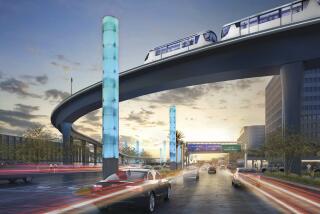Douglas Wins Contract for Air Force Cargo Jet : C-17 Program Is Worth $3.39 Billion, Will Bring 3,000 Jobs and Major Expansion at Long Beach
- Share via
The Air Force said Thursday that it has awarded McDonnell Douglas Corp. a $3.39-billion contract to develop the C-17 military cargo plane at its Douglas Aircraft plant in Long Beach, a program that will spur the firm to make a major plant expansion and to hire 3,000 new employees this year.
McDonnell Douglas said it will build five new facilities at its huge factory bordering the Long Beach airport at a cost of more than $100 million. It also said a majority of the 3,000 new employees will be assigned to the C-17 program. The company said that eventually 13,000 workers will be employed on the program, which now has about 1,000 assigned to it.
The contract award, which was made Tuesday, has been anxiously awaited by McDonnell Douglas. It is a milestone in a program that is slated to be among the largest military procurement programs of the 1990s.
The Air Force plans to buy 210 of the stubby-looking cargo jets at a cost of $37.8 billion, including future inflation. That represents a substantially larger program than either the B-1 bomber, the MX missile or the F-15 fighter jet.
Large Loads
The cargo jet, which will be powered by four Pratt & Whitney jet engines, will be large enough to stow up to six helicopters or as many as 18 jeeps. It will also be able to carry combinations of tanks, trucks and a variety of armored vehicles.
The C-17 program’s current work force of 1,000 grew from about 400 in 1984. Douglas has 20,500 employees and also is aggressively hiring workers for several other civilian and military aircraft programs.
Joseph D. Van Dyke, McDonnell Douglas vice president and C-17 program general manager, said Thursday that the contract award “shows the continuing confidence of the Air Force in our develop ment efforts at this point.”
Construction of the new buildings at the Douglas factory is expected to begin later this year. Douglas will add about 1 million square feet of factory space to its existing 7 million square feet. The facility is already among the largest aircraft production sites in Southern California.
Production in 1988
Douglas plans to begin assembly of a C-17 test aircraft in late 1987 and to fly it in 1990. It will also build two airframes for tests on the ground, subjecting the fuselage, wings and other structures to simulated flight stresses to make sure they remain intact. It is expected to enter production in 1988.
By then, Douglas will be simultaneously producing or developing more than three military aircraft and three to four commercial aircraft, the busiest pace at the company in many years. Douglas reported its first profit in a decade in July, 1984, and has remained profitable since then.
The C-17 has been stymied at several times in recent years by the political gamesmanship of rivals who have sought to kill the program. Lockheed Corp., the Air Force’s principal supplier of cargo aircraft, successfully delayed the C-17 in 1982 when it convinced the Defense Department to renew production of the C-5 cargo jet.
While the C-17 program has survived that blow, it has been delayed so much that it will have to survive in a much more difficult political climate than if it had entered development in 1982.
Pressure on Budget
Pressure on the defense budget in the late 1980s is expected to permit very few, if any, new programs to enter production. At the same time, Lockheed has continued its efforts to sell the Air Force additional C-5s.
And yet, the C-17 has received unusually strong support from the Pentagon. Unlike certain weapons, cargo and personnel transportation is a necessity to all the services.
Congress appropriated $383.7 million for the C-17 in fiscal 1986. McDonnell Douglas’ share is $343 million and the balance goes to the military and to Pratt & Whitney.
The military currently lacks the capability to deploy forces rapidly around the world and the C-17 is specifically designed to fly cargo from the United States into small foreign air fields near the front lines of fighting. The existing aircraft fleet transports cargo in a two-step process: the cargo is first ferried aboard large jets to major airports and then into small fields by smaller prop-jets.
The C-17 will cost an average of $180 million each.
More to Read
Inside the business of entertainment
The Wide Shot brings you news, analysis and insights on everything from streaming wars to production — and what it all means for the future.
You may occasionally receive promotional content from the Los Angeles Times.











